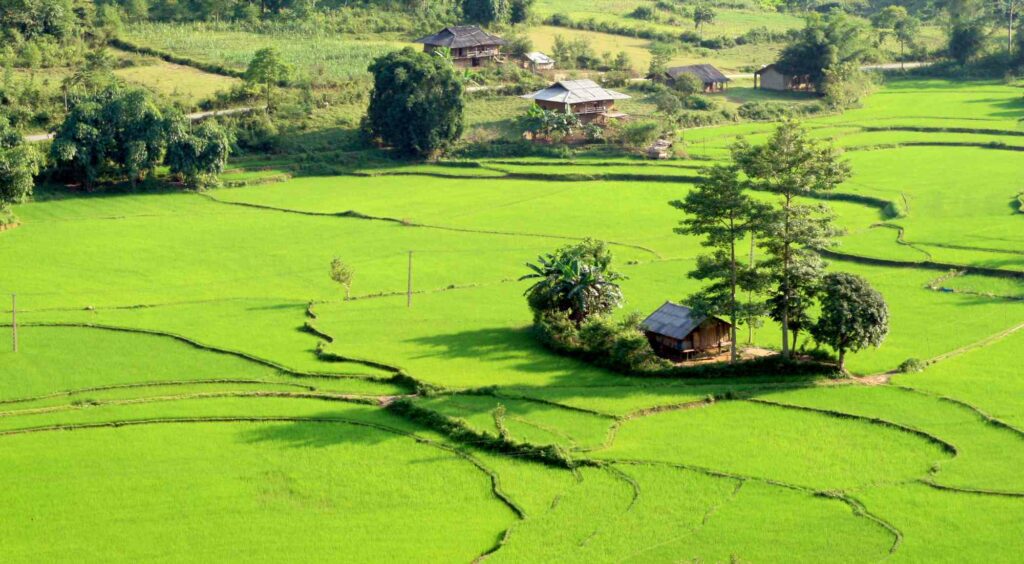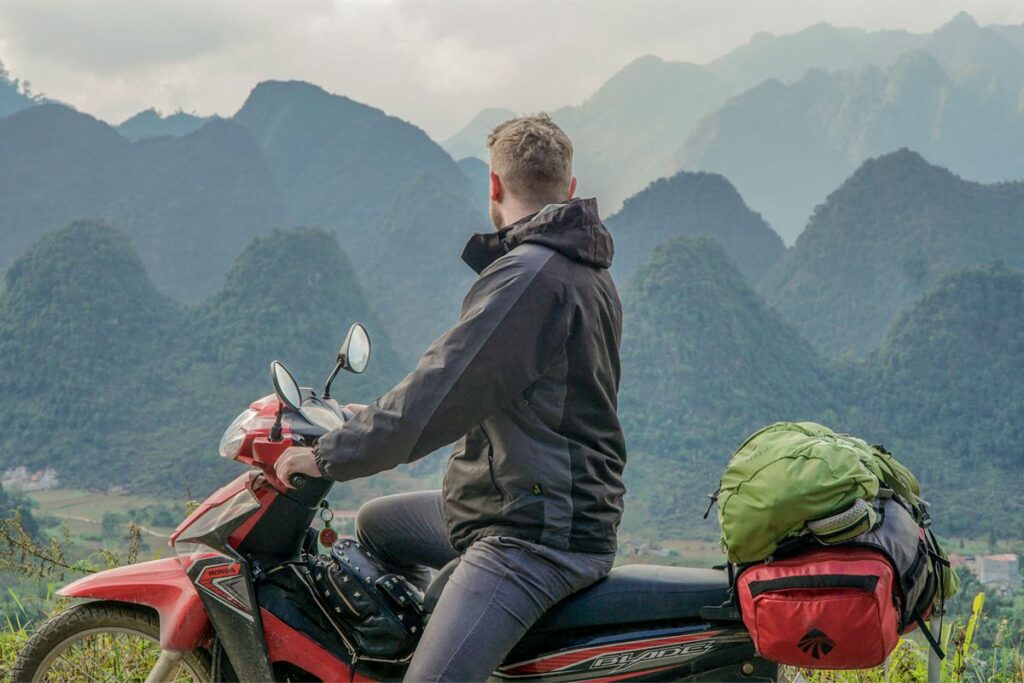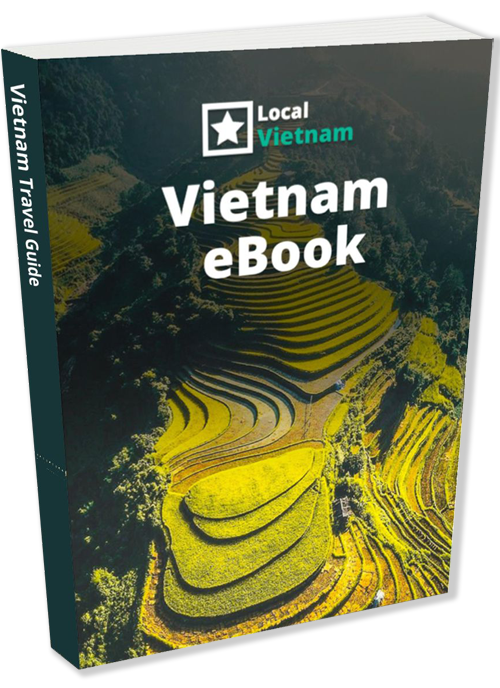About Du Gia
Nestled in the remote mountains of Ha Giang, Du Gia is a commune in Yen Minh District, known for its peaceful atmosphere, stunning terraced rice fields, and traditional ethnic villages. Surrounded by majestic limestone mountains and lush valleys, this off-the-beaten-path destination offers a glimpse into authentic rural life in northern Vietnam. The commune is home to Tay, Hmong, and Dao ethnic minorities, who continue their age-old traditions of farming, weaving, and communal living. Small wooden and stilt houses are scattered across the hills, and livestock roam freely along winding dirt roads.
One of Du Gia’s most famous attractions is the Du Gia Waterfall, a scenic spot where travelers can swim in cool, clear waters. Beyond the waterfall, visitors can explore ethnic markets, hidden trails, and quiet villages, where warm hospitality and traditional homestay experiences provide an authentic alternative to the more developed stops along the Ha Giang Loop. While many travelers visit as part of an extended Ha Giang Loop itinerary, the serene landscapes and welcoming local culture make it a destination worth savoring at a slower pace.
How do you get there?
Du Gia is not a standalone destination but rather a scenic stop along the Ha Giang Loop, a legendary motorbike route through Vietnam’s far north. Located between Ha Giang City and Meo Vac, it is either the first stop after leaving Ha Giang City or the final stop before returning, depending on your route. There are no direct buses to Du Gia, so the only way to reach it is by motorbike, car, or jeep. While the roads can be challenging, they offer incredible mountain scenery and remote ethnic villages, making the journey itself a highlight.
Tip: Stay overnight in Du Gia on a Ha Giang tour
Du Gia is a peaceful village often included as an overnight stop in our Ha Giang Loop tours. All tours include transfers, local guides or drivers, and cozy homestays. Discover all tour options that feature Du Gia here.
Getting to Ha Giang City
To begin the Ha Giang Loop, you first need to get to Ha Giang City, which is only accessible by road:
- Sleeper bus from Hanoi: Takes around 6-7 hours, departing in the evening and arriving early morning.
- Daytime limousine vans: More comfortable, with multiple departures throughout the day.
- Private car: The most convenient option but also the most expensive.
How to travel the Ha Giang Loop
Once in Ha Giang City, you can choose one of the following ways to travel the loop and reach Du Gia:
- Motorbike: The most adventurous and flexible way to explore. Recommended only for experienced riders due to winding mountain roads.
- Easy Rider tour: If you don’t want to ride yourself, you can sit on the back of a motorbike with an experienced local guide.
- Jeep or car tour: The safest and most comfortable option, ideal for those who prefer not to ride a motorbike but still want to experience the stunning landscapes.
Routes to Du Gia
Depending on your direction, Du Gia can be reached from Ha Giang City or Meo Vac:
- From Meo Vac: Via Mau Due – DT176 (70 km) – a spectacular but challenging route.
- From Ha Giang (Option 1): Via QL4C + DT181 (70 km) – a shorter but more rugged road.
- From Ha Giang (Option 2): Via QL34 + DT176 (110 km) – a longer but smoother alternative.
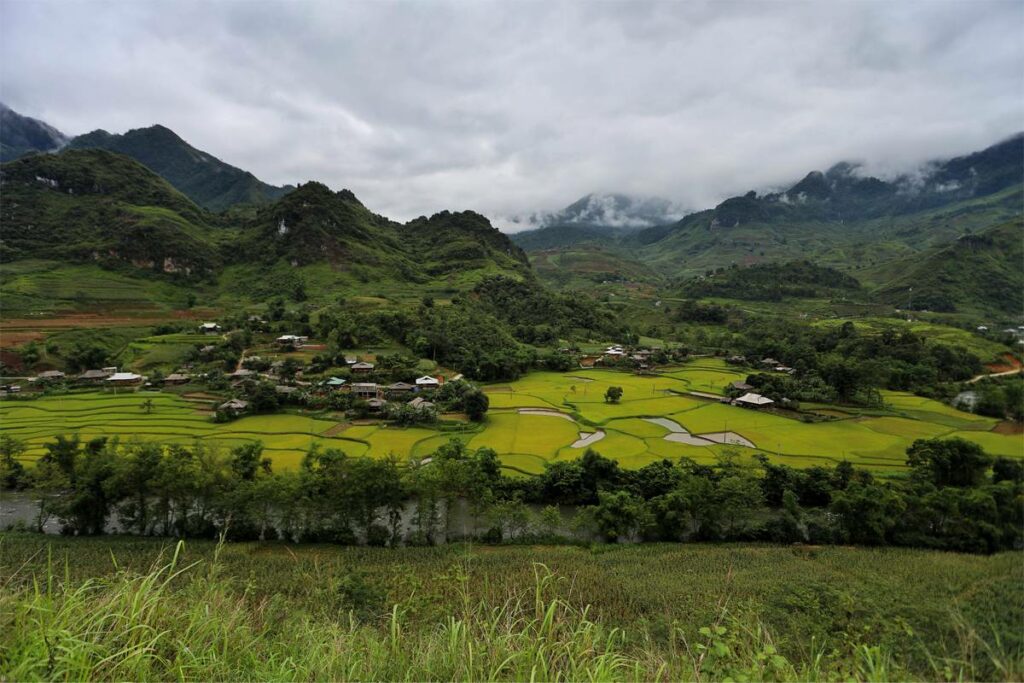
Du Gia – Mau Due scenic route
The most spectacular stretch to drive is between Mau Due and Du Gia. It is not the safest road with many holes and bends. The mountain passes are impressive, perhaps even more so than around Dong Van. In some areas you can see many rice terraces that turn golden yellow during the right season. Along the way you will find a ruin of a French watchtower from the colonial era. Expect to give a lot of high fives to the kids along the way who greet you kindly.
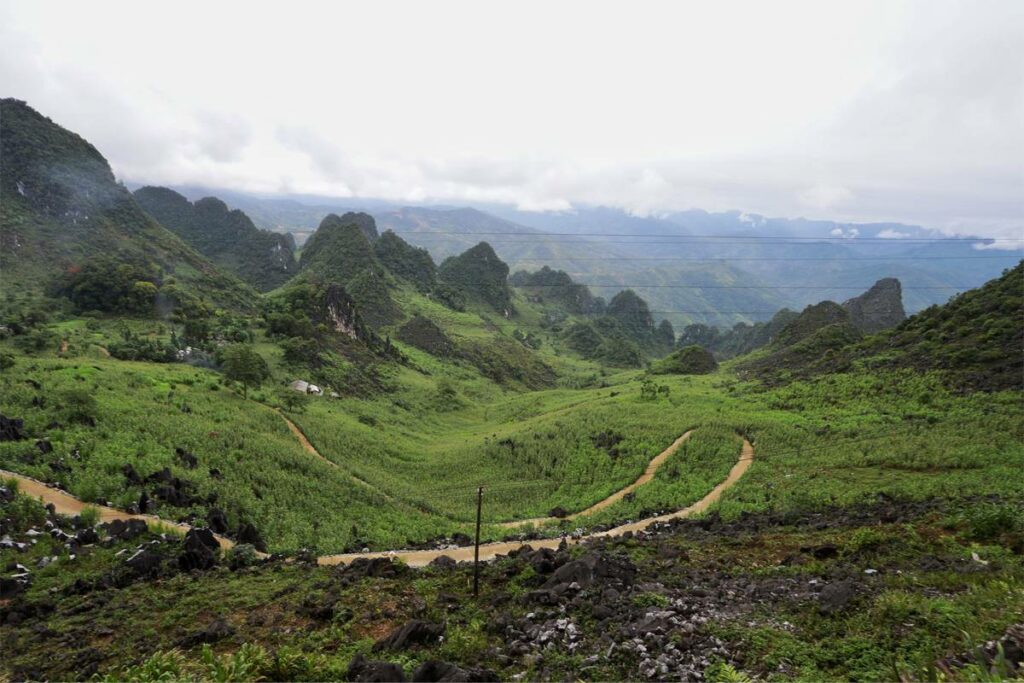
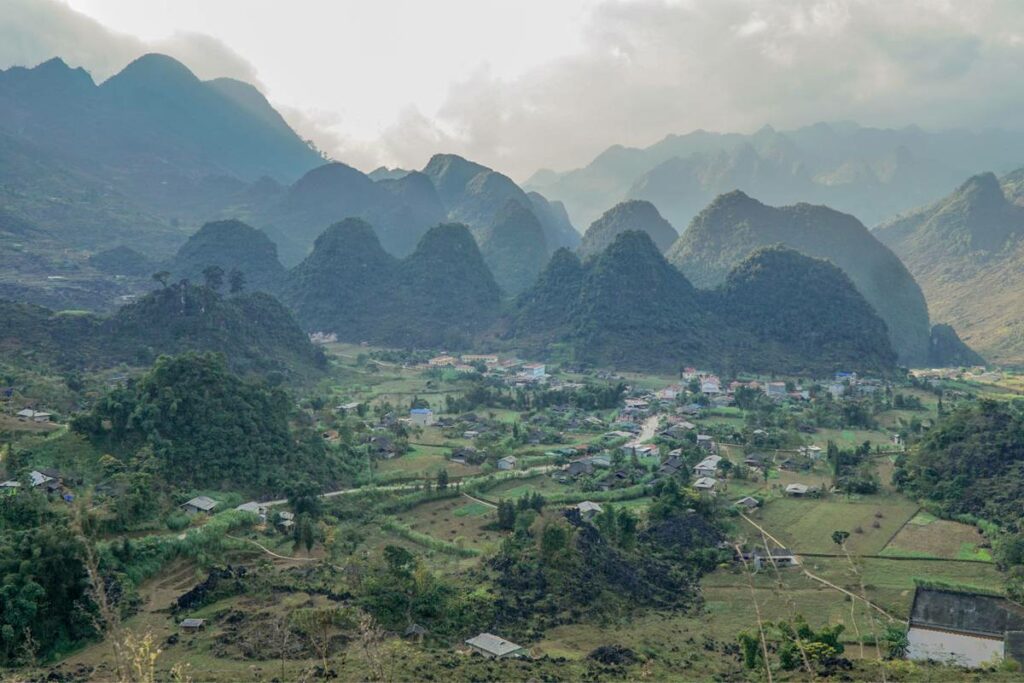
Du Gia Waterfall
One of the most popular attractions in Du Gia is the Du Gia Waterfall, a beautiful multi-tiered cascade that flows into a natural swimming pool. The waterfall is surrounded by lush greenery and large rocks, making it an ideal spot to cool off and relax. The pool at the base of the waterfall is deep enough for swimming, and there are a few rock formations where you can jump into the water—a favorite activity among visitors.
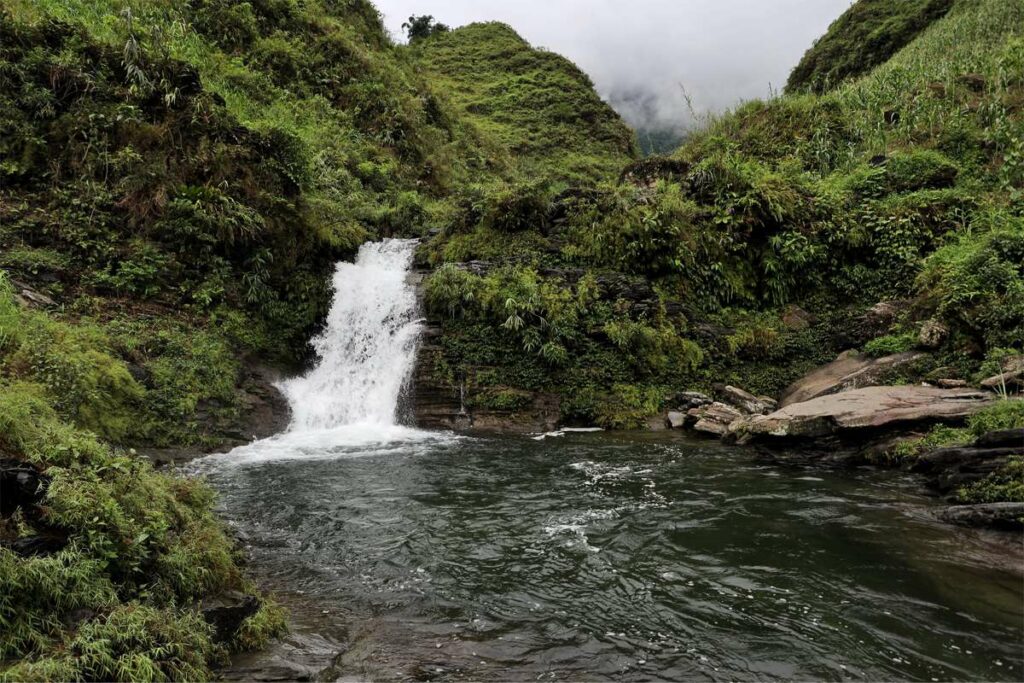
The best time to visit is during the hot summer months, from May to September, when the water is refreshing, and the temperatures are ideal for swimming. Spring (March-April) and autumn (October-November) can also be pleasant, though the water might be cooler. Winter (December-February) is generally too cold for swimming, but the waterfall is still a scenic spot to visit.
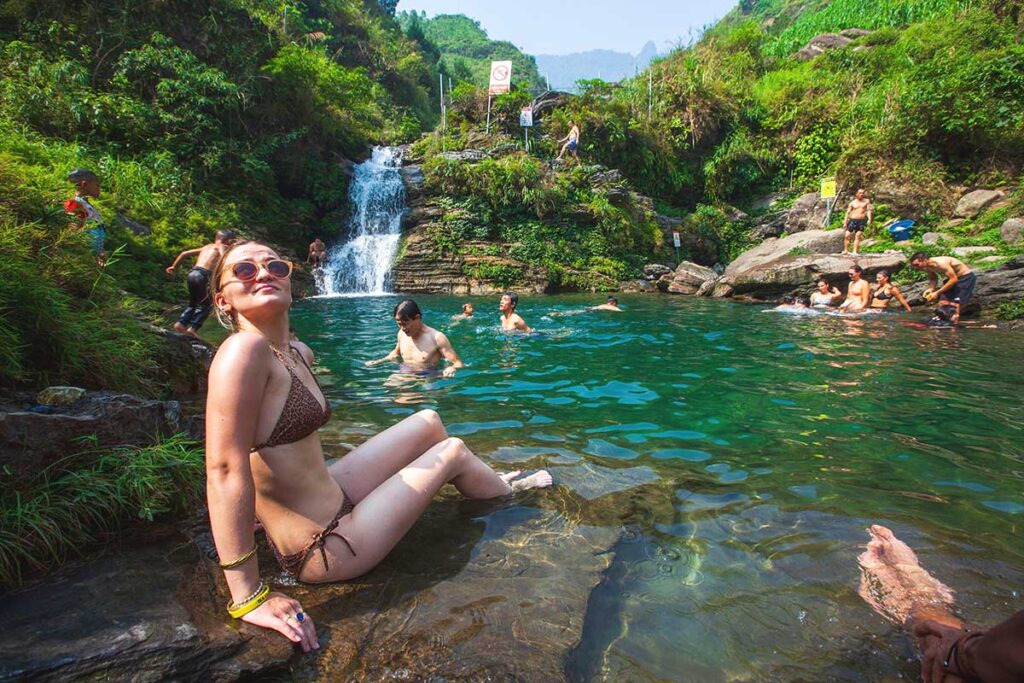
It’s important to note that Du Gia has become a popular stop for group tours, especially in the late afternoon, when large groups from motorbike tours arrive. If you enjoy a lively atmosphere and socializing with fellow travelers, this can be a fun experience. However, if you prefer a quieter setting, it’s best to visit in the morning or early afternoon before the crowds arrive.
The waterfall is located just a few kilometers from the main village and can be reached on foot, by bicycle, or by motorbike. The trail leading to it is not difficult, but caution is needed when walking over wet rocks.
What to do and see in Du Gia
Du Gia is a quiet and peaceful commune, offering travelers a chance to immerse themselves in nature and experience the authentic rural life of northern Vietnam. While there are no big attractions or major sights, the beauty of Du Gia lies in its landscapes, ethnic culture, and local hospitality.
1. Explore Ethnic Minority Life
The region is home to several ethnic minority groups, primarily the Tay, Hmong, and Dao people, who live in traditional wooden stilt houses surrounded by rice fields. A walk through Du Gia’s villages gives you a glimpse of daily rural life, where locals are seen herding buffalos, tending to rice paddies, and carrying baskets of crops along dirt paths. Along the way, you’ll also spot ducks, pigs, and chickens roaming freely, adding to the charming, pastoral atmosphere.

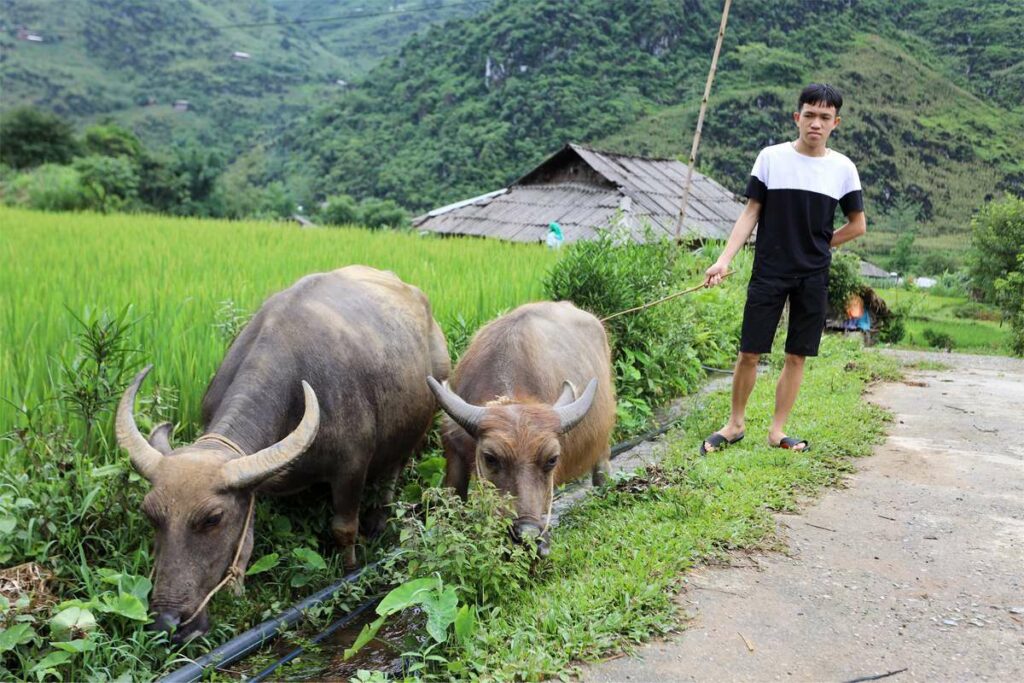
The best way to explore is by walking, as the village and surrounding areas are peaceful and scenic. If you prefer a slightly faster pace, cycling is an excellent option, though finding a rental bicycle can be difficult. Another way to get around is by motorbike, but since you’ve likely been riding all day on the Ha Giang Loop, a more relaxing way to experience the area might be preferable.
Every Saturday morning, Du Gia hosts a local market, where ethnic communities from surrounding villages come to trade fresh produce, livestock, textiles, and household goods. It’s a great place to observe the vibrant traditional clothing worn by different ethnic groups and to experience the lively social atmosphere, as locals gather to shop, chat, and share a drink.
2. Stay in an Ethnic Homestay
Over the past few years, Du Gia has grown in popularity among travelers, leading to a rise in homestays. Originally, there was just one homestay in the village, but now, there are multiple options, ranging from traditional stilt houses run by ethnic families to more modern accommodations owned by lowland Vietnamese entrepreneurs.
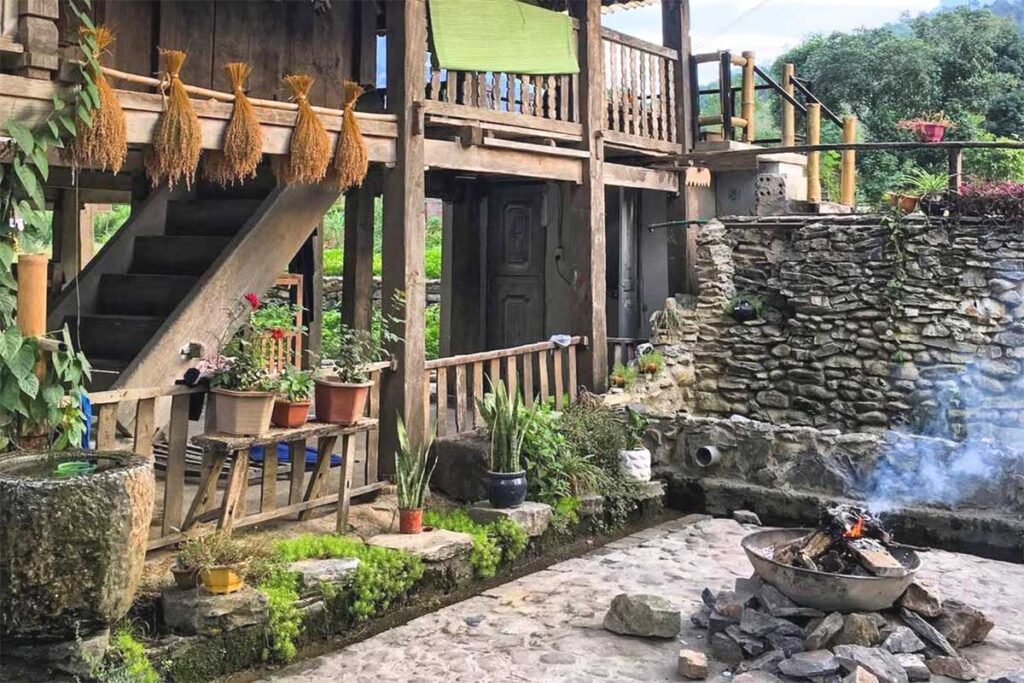
- Traditional homestays offer a rustic and authentic experience, where you sleep in a bamboo or wooden house on stilts, often with thin mattresses and mosquito nets. You’ll be welcomed by a local family, share home-cooked meals, and might even be invited to drink homemade rice or corn wine.
- Modern homestays are often more comfortable, with private rooms, better amenities, and sometimes even Western-style bathrooms. While they might not provide the same level of cultural immersion, they are a good option if you prefer a more comfortable stay.
Despite being a small village, Du Gia’s homestays are some of the highest-rated accommodations in Ha Giang, praised for friendly hosts, peaceful settings, and great food.
3. Swimming at Du Gia Waterfall
Since Du Gia Waterfall is one of the main highlights of the area, taking a refreshing swim is a must if you visit during the warmer months. The natural pool is perfect for cooling off, and for the more adventurous, you can jump off the surrounding rocks into the water. If you prefer a quieter experience, visit earlier in the day, as large tour groups tend to arrive in the late afternoon.
A few kilometers from the village is a waterfall that you can walk to. There is a natural pool where you can cool off and there are rocks that you can jump off.
4. Bamboo Rafting at Tham Lin Cave
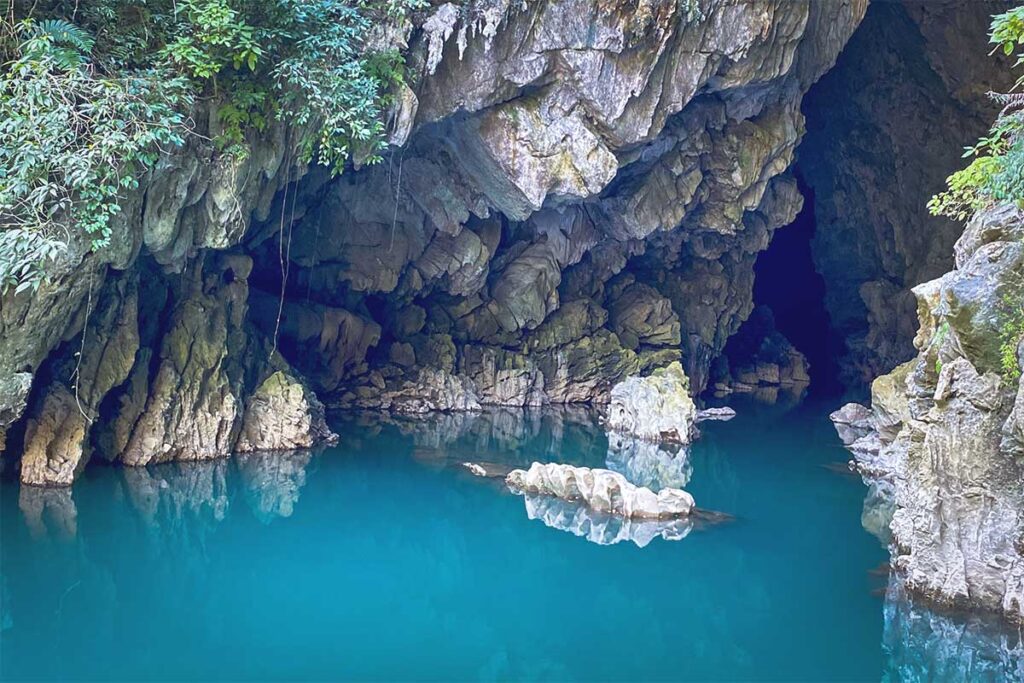
Located about one hour from Du Gia, Hang Thầm Lín (Tham Lin Cave) is an off-the-beaten-path natural attraction in Yen Minh district. A stream flows from the cave, creating a serene setting for swimming, bamboo rafting, and even camping. For a small fee, you can rent a traditional bamboo raft or an inflatable boat and glide through the peaceful waters leading into the cave. The water is shallow in some areas, but be mindful of the rocks beneath the surface.
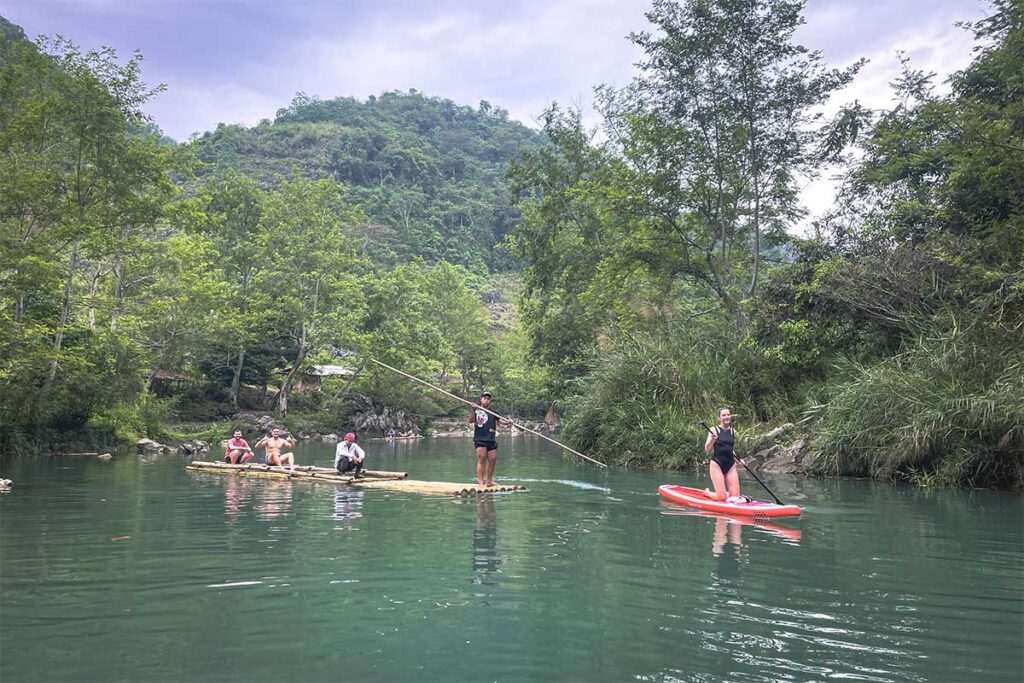
While the experience is tranquil in dry weather, it’s important to check conditions before visiting, as recent rainfall can cause the water flow to be too strong for the rafts to operate. The road to the site is scenic but challenging, requiring careful driving. If you’re traveling from Meo Vac to Du Gia, this is a unique alternative to the Du Gia Waterfall, offering a less crowded and more immersive natural experience. A local family runs the site, offering basic food and camping options, but services are limited, so it’s best to bring some essentials.
5. Enjoy the Viewpoint at Ta Muong Village
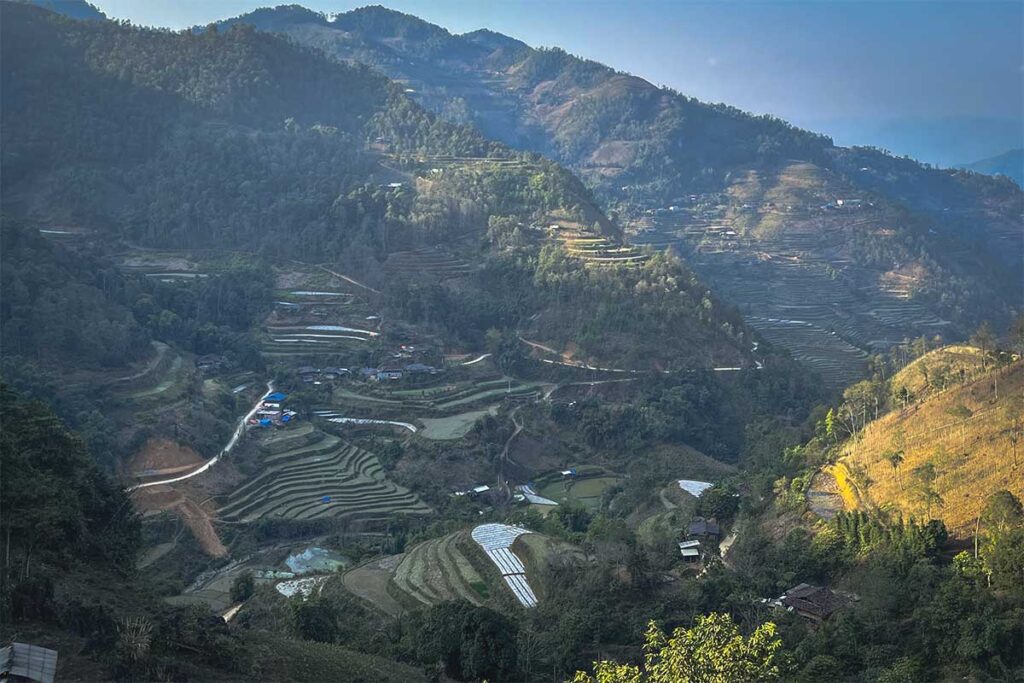
For those seeking a hidden gem, Ta Muong Village is one of the most scenic stops in the Yen Minh district, offering breathtaking views over a valley of terraced rice fields. Located 1.5 hours from Du Gia, it’s a remote yet rewarding destination that few travelers venture to. A small, rustic café sits at the viewpoint, providing a place to rest, enjoy a drink, and take in the spectacular scenery. The café is very basic, with plastic chairs and a few drink options, but the stunning landscape makes it worth the stop.
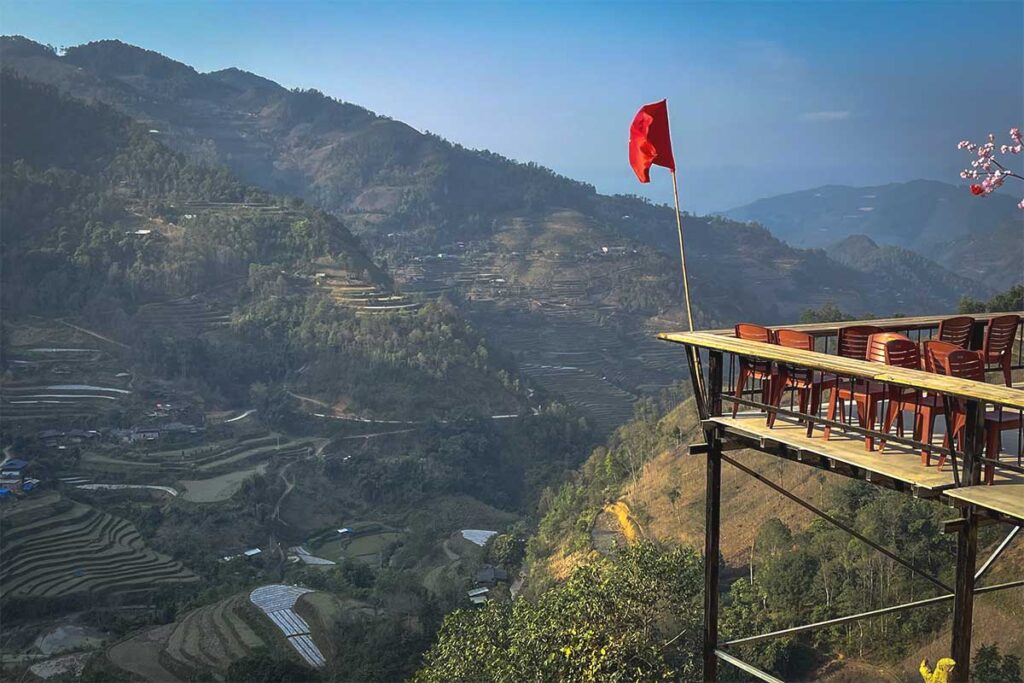
Reaching Ta Muong Village requires following the same road as Tham Lin Cave, making it a great combined trip for those looking to explore beyond the main Ha Giang Loop route. However, it’s important to plan your time carefully, as the detour adds significant travel time and the road conditions can be challenging. Despite this, the peaceful atmosphere and incredible panoramic views make it a fantastic hidden spot for those wanting to experience the untouched beauty of Ha Giang.
Staying in Du Gia
Du Gia offers a different experience from most other stops along the Ha Giang Loop. Unlike the rugged mountain landscapes of Dong Van and Meo Vac, Du Gia sits in a valley surrounded by lush rice fields, rolling hills, and serene countryside. This lower elevation also means that winters are milder, making it a comfortable place to stay year-round. The peaceful atmosphere and scenic surroundings make Du Gia a great overnight stop, especially if you enjoy relaxing nature, swimming at the waterfall, or experiencing ethnic village life.
However, Du Gia has also become a popular stop for large motorbike tour groups, who often stay overnight and visit the waterfall in the late afternoon. Some homestays cater to a social, party-like atmosphere, where travelers gather for family dinners and drinks, while others offer a quiet retreat in nature. Depending on your preference, it’s worth choosing your accommodation carefully—whether you want to join the lively atmosphere or opt for a more peaceful stay.
Where to stay in Du Gia?
Over the past few years, Du Gia has grown in popularity, and with that, the number of homestays has increased significantly. While you still won’t find hotels or resorts, you now have a wider choice between traditional ethnic homestays and modern homestays with more hotel-like comforts.
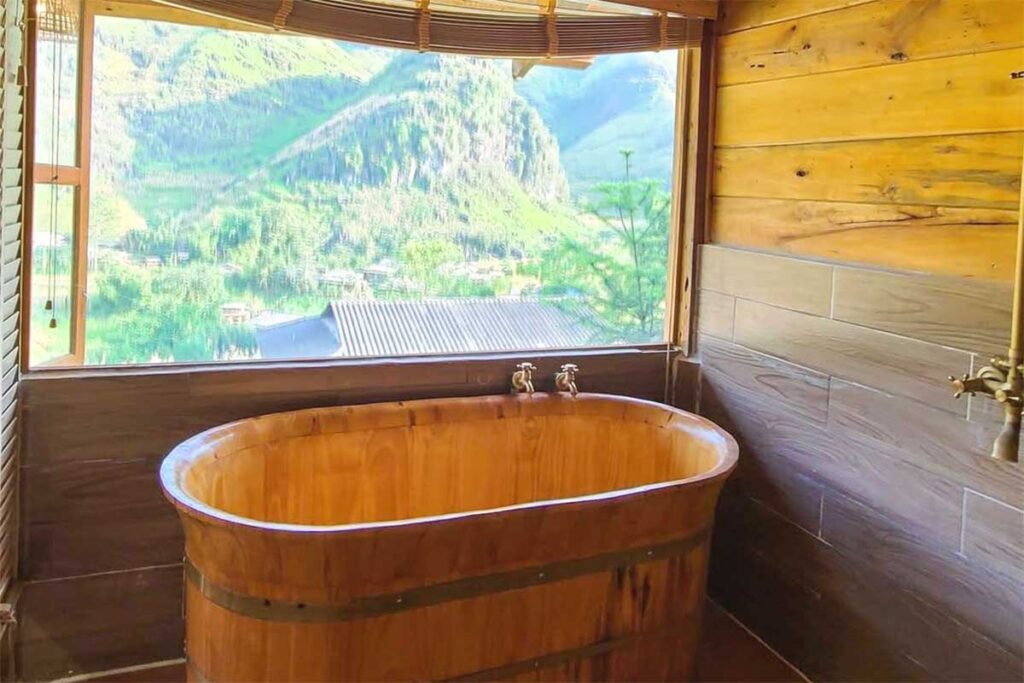
- Traditional homestays – These are typically wooden stilt houses run by Tay or Hmong families, offering a local experience. The rooms are basic, with thin mattresses, mosquito nets, and shared bathrooms, but the hospitality and family dinners make up for the simplicity.
- Modern homestays – Some newer homestays, often run by Vietnamese from the lowlands, offer more comfortable private rooms with en-suite bathrooms, Western-style amenities, and sometimes even bungalows. While they may lack the authentic ethnic homestay atmosphere, they are a good option if you prefer more comfort.
Popular homestays in Du Gia
- Du Gia Homestay – One of the most well-known, popular among backpackers, offering dorms, private rooms, and bungalows with mountain views and social family dinners.
- QT Du Gia Homestay – A good mix between social and comfortable, with good food and welcoming hosts.
- Du Gia Backpacker Hostel & Trekking – Great for meeting other travelers, with a lively backpacker vibe.
- Muong Tra Garden Homestay – A more quiet and scenic option, ideal for relaxing in nature.
Whether you’re looking for a social stay with other travelers or a peaceful retreat in nature, Du Gia has a range of homestays to suit different preferences. It’s a great overnight stop, offering beautiful landscapes, a chance to swim in the waterfall, and a break from the more mountainous terrain of the Ha Giang Loop.
